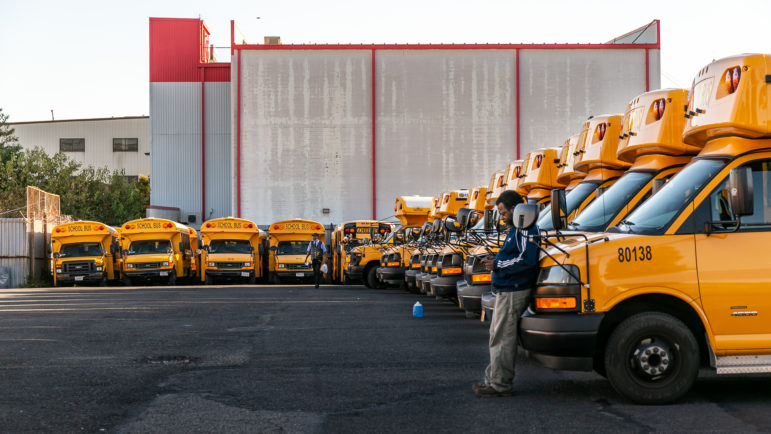Mayor Adams announced this week that the Big Apple is getting 180 new electric school buses. But the city’s fleet still has over 10,000 buses running on polluting fossil fuels.

Adi Talwar
School buses parked in East New York, Brooklyn.This week, New York City secured $61.1 million in federal funding from the Environmental Protection Agency (EPA) for 180 new electric school buses—grant money to help the city move away from powering its fleet with oil and gas, the polluting fossil fuels that contribute to global warming.
“This grant will allow us to put more electric vehicles on our streets and take thousands of pounds of CO2 out of our air,” Mayor Eric Adams said at a press conference in the Bronx on Monday to announce the initiative.
The city, however, still has a long way to go before guaranteeing all school buses in operation will be electric by 2035, as required by state law, which also mandates all new buses purchased in 2027 and after be zero-emission vehicles.
There are currently only 50 electric school buses in the city’s fleet and over 10,000 still running on gas and oil.
The Environmental Bond Act, approved by New York voters in 2022, makes over $500 million available for school bus electrification efforts across the state. But the money can’t go a long way when the costs for going electric remain pricey, environmentalists warn.
“One of the major obstacles we face to electrifying vehicles is always lack of funding. Right now, an electric bus costs more than a diesel or gas operated bus,” said Kevin Garcia, senior transportation planner at the New York City Environmental Justice Alliance (NYC-EJA).
A small electric school bus that carries up to 30 passengers costs between $259,000 and $292,000, while comparable diesel-run models cost around $66,000 to $87,000, according to the non-profit New York League of Conservation Voters. Full-size buses can cost from around $319,000 to $453,000 in electric form, versus between $122,000 to $174,000 for diesel.
Prices will go down, Garcia explains, once the demand for electric buses spurs increased production from automakers.
“All this funding coming in from the federal government really sends a strong message to manufacturers that there is a need for electric school bus production and charging infrastructure, so they will start making more of them,” Garcia said.
And the federal dollars pouring into New York for electric school buses is also a great starting point for tackling pollution, advocates say.
“It is important that we start to consider the seriousness of breathing clean air, and I think electrification of school bus fleets is the way to get there,” said Suhali Mendez, policy and legislative coordinator at New York Lawyers for the Public Interest (NYLPI).
A December report by NYLPI and other environmental groups found that 20 to 25 percent of buses parked outside of schools across the city violated local laws by idling their engines for more than one minute.
“These chemicals react in the air to form smog,” the report says, noting that “exposure can result in numerous health conditions, including cardiovascular and respiratory diseases.”
Alia Soomro, deputy director of NYC policy for the New York League of Conservation Voters, said the EPA bus funding “marks a major step forward in New York City’s effort to reduce emissions and protect our school children from harmful pollution that has fueled the asthma epidemic, especially in communities of color.”
“In the South Bronx, for example, asthma rates for children top 13.3 [percent], nearly twice the national average. It needs to stop,” Soomro said in an email.
But while switching to electricity helps prevent school children from breathing in bus fumes, its impact on halting climate change is limited, some environmentalists say—at least currently.
“This school bus electrification effort is a health win, but it’s not much of a climate win,” said Charles Komanoff, an energy-policy analyst, transport economist and environmental activist.
Komanoff points out that New York doesn’t have enough clean energy feeding into the electric grid at the moment to power these buses with electricity that doesn’t contribute to global warming.
Just 27 to 29 percent of the state’s electricity currently comes from renewable energy, according to the New York League of Conservation Voters. The state’s goal is to up that to 70 percent by 2030.
Still, officials this week heralded the federal dollars for new electric buses as a positive step.
The funding, which comes from the federal Bipartisan Infrastructure Law, also provides $15 million from the U.S. Department of Transportation’s (USDOT) Charging and Fueling Infrastructure Grant Program to build an electric truck and vehicle charging depot at the Hunts Point Food Distribution Center.
“This is how we clean the environment, this is how we clean the air, a bus at a time,” Congressmember Adriano Espaillat said at the announcement.
To reach the reporter behind this story, contact Mariana@citylimits.org. To reach the editor, contact Jeanmarie@citylimits.org
Want to republish this story? Find City Limits’ reprint policy here.








